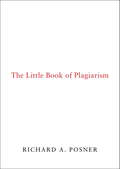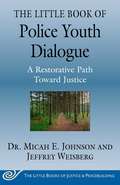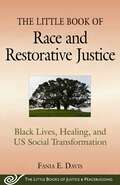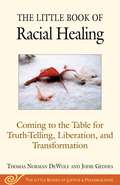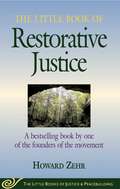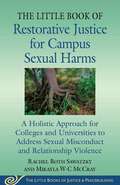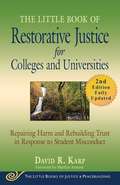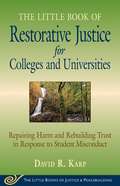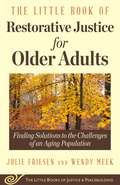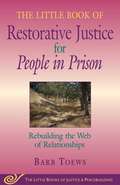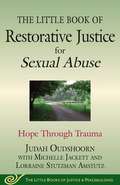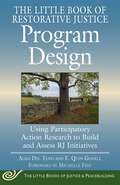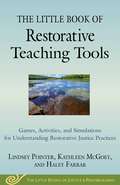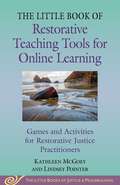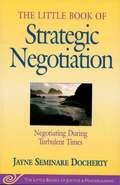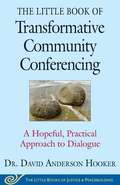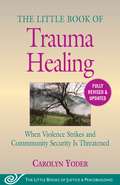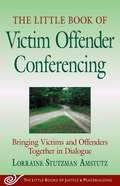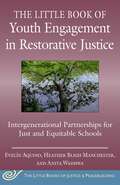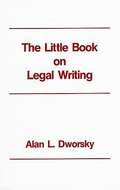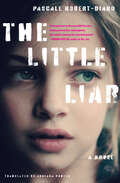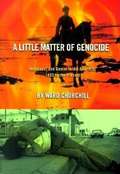- Table View
- List View
The Little Book of Plagiarism
by Richard A. PosnerA concise, lively, and bracing exploration of an issue bedeviling our cultural landscape–plagiarism in literature, academia, music, art, and film–by one of our most influential and controversial legal scholars. Best-selling novelists J. K. Rowling and Dan Brown, popular historians Doris Kearns Goodwin and Stephen Ambrose, Harvard law professor Charles Ogletree, first novelist Kaavya Viswanathan: all have rightly or wrongly been accused of plagiarism–theft of intellectual property–provoking widespread media punditry. But what exactly is plagiarism? How has the meaning of this notoriously ambiguous term changed over time as a consequence of historical and cultural transformations? Is the practice on the rise, or just more easily detectable by technological advances? How does the current market for expressive goods inform our own understanding of plagiarism? Is there really such a thing as “cryptomnesia,” the unconscious, unintentional appropriation of another’s work? What are the mysterious motives and curious excuses of plagiarists? What forms of punishment and absolution does this “sin” elicit? What is the good in certain types of plagiarism? Provocative, insightful, and extraordinary for its clarity and forthrightness,The Little Book of Plagiarismis an analytical tour de force in small, the work of “one of the top twenty legal thinkers in America” (Legal Affairs), a distinguished jurist renowned for his adventuresome intellect and daring iconoclasm.
The Little Book of Police Youth Dialogue: A Restorative Path Toward Justice (Justice and Peacebuilding)
by Dr. Micah E. Johnson Jeffrey WeisbergDiscover the police-youth dialogue (PYD) as a method to build trustworthiness, mend relationships, and heal historical harms between black youth and law enforcement. This timely book from the Justice and Peacebuilding series offers an explanation of the need for meaningful dialogue between law enforcement and black youth, a blueprint for implementing police-youth dialogues, best practices and examples, anecdotes and narratives from participants, different models and formats, potholes and limitations, and tangible tools and action steps for starting a police-youth dialogue program. Ultimately, the strategies and techniques used in effective police-youth dialogues can bring attention to issues of implicit bias and the impact of toxic stress on marginalized groups, ameliorate tensions between law enforcement officers and black youth, and build toward a model of community policing and restorative justice rather than punitive discipline and violence.The Little Book of Police-Youth Dialogue presents readers with relevant knowledge and research regarding trauma and race in the United States, strategies for creating a safe space of attentive listening and mediating genuine connections between police officers and black youth, and specific ways to take action in ameliorating police-youth tensions and promoting healing in their local communities.
The Little Book of Race and Restorative Justice: Black Lives, Healing, and US Social Transformation (The Little Books of Justice and Peacebui)
by Fania E. DavisRacial Justice and Restorative Justice Working Together to Transform the Black Experience in America This timely work will inform scholars and practitioners on the subjects of pervasive racial inequity and the healing offered by restorative justice practices. Addressing the intersectionality of race and the US criminal justice system, social activist Fania E. Davis explores how restorative justice has the capacity to disrupt patterns of mass incarceration through effective, equitable, and transformative approaches. Eager to break the still-pervasive, centuries-long cycles of racial prejudice and trauma in America, Davis unites the racial justice and restorative justice movements, aspiring to increase awareness of deep-seated problems as well as positive action toward change. In The Little Book of Race and Restorative Justice, Davis highlights real restorative justice initiatives that function from a racial justice perspective; these programs are utilized in schools, justice systems, and communities, intentionally seeking to ameliorate racial disparities and systemic inequities. Furthermore, she looks at initiatives that strive to address the historical harms against African Americans throughout the nation. This newest addition the Justice and Peacebuilding series is a much needed and long overdue examination of the issue of race in America as well as a beacon of hope as we learn to work together to repair damage, change perspectives, and strive to do better.
The Little Book of Racial Healing: Coming to the Table for Truth-Telling, Liberation, and Transformation (The Little Books of Justice and Peacebui #1)
by Thomas Norman Dewolfe Geddes JodiePeople of color, relative to white people, fall on the negative side of virtually all measurable social indicators. The “living wound” is seen in the significant disparities in average household wealth, unemployment and poverty rates, infant mortality rates, access to healthcare and life expectancy, education, housing, and treatment within, and by, the criminal justice system. Coming to the Table (CTTT) was born in 2006 when two dozen descendants from both sides of the system of enslavement gathered together at Eastern Mennonite University (EMU), in collaboration with the Center for Justice & Peacebuilding (CJP). Stories were shared and friendships began. The participants began to envision a more connected and truthful world that would address the unresolved and persistent effects of the historic institution of slavery. This Little Book shares Coming to the Table’s vision for the United States—a vision of a just and truthful society that acknowledges and seeks to heal from the racial wounds of the past. Readers will learn practical skills for better listening; discover tips for building authentic, accountable relationships; and will find specific and varied ideas for taking action.
The Little Book of Restorative Justice: Revised and Updated (Justice and Peacebuilding)
by Howard ZehrHoward Zehr is the father of Restorative Justice and is known worldwide for his pioneering work in transforming understandings of justice. Here he proposes workable principles and practices for making Restorative Justice possible in this revised and updated edition of his bestselling, seminal book on the movement. (The original edition has sold more than 110,000 copies.)Restorative Justice, with its emphasis on identifying the justice needs of everyone involved in a crime, is a worldwide movement of growing influence that is helping victims and communities heal, while holding criminals accountable for their actions.This is not soft-on-crime, feel-good philosophy, but rather a concrete effort to bring justice and healing to everyone involved in a crime. In The Little Book of Restorative Justice, Zehr first explores how restorative justice is different from criminal justice. Then, before letting those appealing observations drift out of reach into theoretical space, Zehr presents Restorative Justice practices. Zehr undertakes a massive and complex subject and puts it in graspable from, without reducing or trivializing it.This resource is also suitable for academic classes and workshops, for conferences and trainings, as well as for the layperson interested in understanding this innovative and influential movement.
The Little Book of Restorative Justice for Campus Sexual Harms: A Holistic Approach for Colleges and Universities to Address Sexual Misconduct and Relationship Violence (Justice and Peacebuilding)
by Rachel Roth Sawatzky Mikayla W-C McCrayA restorative justice approach to addressing sexual misconduct in colleges and universities. Written for college and university practitioners and administrators, The Little Book of Restorative Justice for Campus Sexual Harms: A Holistic Approach to Address Sexual Misconduct and Relationship Violence for Colleges and Universities combines explanation, justification, and contextualization for the application of restorative justice (RJ) for sexual misconduct, including for alleged Title IX violations. This book outlines considerations, action steps, and best practices for campuses that are interested in exploring the successful implementation of RJ for sexual misconduct. The authors' backgrounds as practitioners within the higher education context grounds this work with personal reflections, experiences, and stories. This book provides a primer for colleges and universities who seek to move campus culture in a more restorative direction generally, and specifically for practitioners interested in exploring the possibility of amending existing sexual misconduct policies, including investigative-adjudicatory Title IX policy and procedures, through a restorative justice informed lens. Readers will explore why it makes all the difference (for both students and administrators) to add RJ resolution options.
The Little Book of Restorative Justice for Colleges and Universities, Second Edition: Repairing Harm and Rebuilding Trust in Response to Student Misconduct (Justice and Peacebuilding)
by David R. KarpA Practitioner's Reference and Guide to Implement Restorative Justice on CampusHere’s a call to colleges and universities to consider implementing restorative practices on their campuses, ensuring fair treatment of students and staff while minimizing institutional liability, protecting the campus community, and boosting morale, from an associate dean of student affairs who has put these models to work on his campus.Restorative justice is a collaborative decision-making process that includes victims, offenders, and others who are seeking to hold offenders accountable by having them (a) accept and acknowledge responsibility for their offenses, (b) to the best of their ability, repair the harm they caused to victims and communities, and (c) work to reduce the risk of re-offense by building positive social ties to the community. David Karp writes in his introduction, “As a student affairs administrator, I have become deeply committed to the concept and practice of restorative justice. I have experienced how it can work given the very real pressures among campus conduct administrators to manage high case loads, ensure fair treatment, minimize institutional liability, protect the campus community, boost morale in a division with high turnover, and help students learn from their mistakes without creating insurmountable obstacles to their future successes.”
Little Book of Restorative Justice for Colleges & Universities: Revised & Updated
by David KarpHere’s a call to colleges and universities to consider implementing restorative practices on their campuses, ensuring fair treatment of students and staff while minimizing institutional liability, protecting the campus community, and boosting morale. From an associate dean of student affairs who has put these models to work on his campus. Restorative justice is a collaborative decision-making process that includes victims, offenders, and others who are seeking to hold offenders accountable by having them (a) accept and acknowledge responsibility for their offenses, (b) to the best of their ability, repair the harm they caused to victims and communities, and (c) work to reduce the risk of re-offense by building positive social ties to the community. David Karp writes in his introduction, "As a student affairs administrator, I have become deeply committed to the concept and practice of restorative justice. I have experienced how it can work given the very real pressures among campus conduct administrators to manage high case loads, ensure fair treatment, minimize institutional liability, protect the campus community, boost morale in a division with high turnover, and help students learn from their mistakes without creating insurmountable obstacles to their future successes. "
The Little Book of Restorative Justice for Older Adults: Finding Solutions to the Challenges of an Aging Population (Justice and Peacebuilding)
by Julie Friesen Wendy MeekExploring Restorative Justice Practices as a Compelling Response to the Challenges of an Aging Population As our global population ages, conflicts and difficult conversations emerge. How will older adults decide who will make end-of-life health and financial decisions for them? When will dad need to move out of his home and into long-term care? We can’t have mom living with us anymore because it’s just too hard. Why are my children fighting over where I will live? Why is my son taking money from me? These are challenging scenarios that ever-increasing numbers of people are facing. Sometimes these difficulties are discussed in catastrophic terms:Untenable health-care costs Exhausted pension funds Crises in home-care and long-term housing And other concerns Certainly, there are some reasons to worry; however, the challenges facing older adults can be an opportunity for positive change. The Little Book of Restorative Justice for Older Adults is about providing safe and respectful processes to assist in resolving conflict and addressing abuse involving older adults, families, caregivers, and communities. Authors Julie Friesen and Wendy Meek explore ideas to help connect and support people, building on the strengths and capacities of older adults and their families, in order to strengthen communities. Restorative justice dialogues help older adults and their families talk constructively and safely to find ways to move forward together.
Little Book of Restorative Justice for People in Prison: Rebuilding The Web Of Relationships (The\little Books Of Justice And Peacebuilding)
by Barb ToewsRestorative justice, with its emphasis on identifying the justice needs of everyone involved in a crime, is helping restore prisoners' sense of humanity while holding them accountable for their actions. Toews, with years of experience in prison work, shows how these practices can change prison culture and society. Written for an incarcerated audience, and for all those who work with people in prison, this book also clearly outlines the experiences and needs of this under-represented part of our society. A title in The Little Books of Justice and Peacebuilding Series.
The Little Book of Restorative Justice for Sexual Abuse: Hope through Trauma (Justice and Peacebuilding)
by Judah Oudshoorn Lorraine Amstutz Michelle JackettRestorative justice is gaining acceptance for addressing harm and crime. Interventions have been developed for a wide range of wrongdoing. This book considers the use of restorative justice in response to sexual abuse. Rather than a blueprint or detailing a specific set of programs, it is more about mapping possibilities. It allows people to carefully consider its use in responding to violent crimes such as sexual abuse. Criminal justice approaches tend to sideline and re-traumatize victims, and punish offenders to the detriment of accountability. Alternatively, restorative justice centers on healing for victims, while holding offenders meaningfully accountable. Criminal justice responses tend to individualize the problem, and catch marginalized communities, such as ethnic minorities, within its net. Restorative justice recognizes that sexual abuse is a form of gender-based violence. Community-based practices are needed, sometimes in conjunction with, and sometimes to counteract, traditional criminal justice responses. This book describes impacts of sexual abuse, and explanations for sexual offending, demonstrating how restorative justice can create hope through trauma.
The Little Book of Restorative Justice Program Design: Using Participatory Action Research to Build and Assess RJ Initiatives (Justice and Peacebuilding)
by Alisa Del Tufo E. Quin GonellA concise and practical guide to bringing the day-to-day practice of restorative justice programs into closer alignment with restorative values.In the past twenty-five years there has been an explosion of programs, projects, and initiatives that use the terms &“restorative justice&” or &“restorative practices.&” This reflects multiple trends: the failures and inhumanity of justice system policies and practices; the unfairness and ineffectiveness of &“zero tolerance&” and other punitive measures adopted in our schools, and the positive impact of those who have promoted restorative practices for the past several decades around the world. This complex mix has generated an array of programs that utilize restorative ideas and practices in a wide variety of ways, such as court diversion, deeply spiritual circle work, and national and international truth and reconciliation projects. Some of these programs are designed to address incidences of harm that fall within large systems (family group conferencing, victim offender dialogue, circles, COSA, etc.) or in schools where they are often focused on addressing incidences of harm in an effort to change the over reliance on suspensions and expulsions as a way to modify student behaviors. There are other experiments in restorative justice that move this work into community settings, with a focus on healing and the creation of more empathic relationships. As the authors know from experience, there is often a gap between values and the reality of day to day practice. This Little Book strives to find ways to shrink that gap and to bring our practice and the structures and methods that employ them into closer alignment with restorative values. Simply put, this book asks, how can we better align restorative theory and practice in our work? In order to have truly restorative programs (programs that strive for consistency between their stated values and their real-life practices) the authors offer some ways to integrate restorative practices and values into the strategies used to design, implement, and assess them. They propose the use of another transformative practice, Participatory Action Research (PAR), as a powerful ally in the work of developing restorative practices and the programs that hold them.
The Little Book of Restorative Teaching Tools: Games, Activities, and Simulations for Understanding Restorative Justice Practices (Justice and Peacebuilding)
by Lindsey Pointer Kathleen McGoey Haley FarrarEngaging Practices for Integrating Restorative Justice Principles in Group Settings As restorative practices spread around the world, scholars and practitioners have begun to ask very important questions: How should restorative practices be taught? What educational structures and methods are in alignment with restorative values and principles? This book introduces games as an effective and dynamic tool to teach restorative justice practices. Grounded in an understanding of restorative pedagogy and experiential learning strategies, the games included in this book provide a way for learners to experience and more deeply understand restorative practices while building relationships and improving skills. Chapters cover topics such as:Introduction to restorative pedagogy and experiential learningHow a restorative learning community can be built and strengthened through the use of games and activitiesHow to design games and activities for teaching restorative practicesHow to design, deliver, and debrief an activity-based learning experienceIn-depth instructions for games and activities for building relationships, understanding the restorative philosophy, and developing skills in practiceAn ideal handbook for educators, restorative justice program directors and trainers, consultants, community group leaders, and anyone else whose work draws people together to resolve disagreements or address harm, this book will serve as a catalyst for greater creativity and philosophical alignment in the teaching of restorative practices across contexts.
Little Book of Restorative Teaching Tools for Online Learning: Games and Activities for Restorative Justice Practitioners (Justice and Peacebuilding)
by Lindsey Pointer Kathleen McGoeyCreating Restorative Learning Experiences Online Teaching, training, and gathering online has become a global norm since 2020. Restorative practitioners have risen to the challenge to shift restorative justice processes, trainings, and classes to virtual platforms, a change that many worried would dilute the restorative experience. How can people build relationships with genuine empathy and trust when they are not in a shared physical space? How can an online platform become an environment for people to take risks and practice new skills without the interpersonal support available when meeting face to face? This book provides instructions for experiential games and activities that are intentionally designed for online learning spaces. It builds upon the core concepts of restorative pedagogy introduced in The Little Book of Restorative Teaching Tools (2020) to guide trainers and facilitators to overcome perceived limitations of virtual training and lean into the tools and possibilities that are unique to online spaces to create meaningful, engaging restorative learning environments. This guide is a valuable resource for anyone seeking to build community and foster development of restorative justice knowledge and skills via online platforms. The games and activities included support building relationships, introducing the restorative justice philosophy, practicing key skills, and understanding and addressing structural and racial injustices. More resources are available at restorativeteachingtools.com.
Little Book of Strategic Negotiation: Negotiating During Turbulent Times
by Jayne DochertyMost books on negotiation assume that the negotiators are in a stable settintg. But what about those far thornier times when negotiation needs to happen while other fundamental factors are in uproarious change- deciding which parent will have custody of their child while a divorce is underway; bargaining between workers and management during the course of a merger and downsizing; or establishing a new government as a civil war winds down. From Docherty's experiences in environmental/public policy negotiations and community development work. A title in The Little Books of Justice and Peacebuilding Series.
The Little Book of Transformative Community Conferencing: A Hopeful, Practical Approach to Dialogue (Justice and Peacebuilding)
by David Anderson HookerWhen conflicts become ingrained in communities, people lose hope. Dialogue is necessary but never sufficient, and often actions prove inadequate to produce substantial change. Even worse, chosen actions create more conflict because people have different lived experiences, priorities, and approaches to transformation. So what’s the story?In The Little Book of Transformative Community Conferencing, David Anderson Hooker offers a hopeful, accessible approach to dialogue that:Integrates several practice approaches including restorative justice, peacebuilding, and artsCreates welcoming, non-divisive spaces for dialogueNames and maps complex conflicts, such as racial tensions, religious divisions, environmental issues, and community development as it narrates simple storiesBuilds relationships and foundations for trust needed to support long-term community transformation projectsAnd results in the crafting of hopeful, future-oriented visions of community that can transform relationships, resource allocation, and structures in service of communities’ preferred narratives.The Little Book Transformative Community Conferencing will prove valuable and timely to mediators, restorative justice practitioners, community organizers, as well as leaders of peacebuilding and change efforts. It presents an important, stand-alone process, an excellent addition to the study and practice of strategic peacebuilding, restorative justice, conflict transformation, trauma healing, and community organizing.This book recognizes the complexity of conflict, choosing long-term solutions over inadequate quick fixes. The Transformative Community Conferencing model emerges from the author’s thirty years of practice in contexts as diverse as South Sudan; Mississippi; Greensboro, North Carolina; Oakland, California; and Nassau, Bahamas.
The Little Book of Trauma Healing: When Violence Strikes and Community Security Is Threatened (Justice and Peacebuilding)
by Carolyn YoderHow do we address trauma, interrupt cycles of violence, and build resilience in a turbulent world of endless wars, nationalism, othering, climate crisis, racism, pandemics, and terrorism? This fully updated edition offers a practical framework, processes, and useful insights.The traumas of our world go beyond individual or one-time events. They are collective, ongoing, and the legacy of historical injustices. How do we stay awake rather than numbing or responding violently? How do we cultivate individual and collective courage and resilience? This Little Book provides a justice-and-conflict-informed community approach to addressing trauma in nonviolent, neurobiologically sound ways that interrupt cycles of violence and meet basic human needs for justice and security. In these pages, you&’ll find the core framework and tools of the internationally acclaimed Strategies for Trauma Awareness and Resilience (STAR) program developed at Eastern Mennonite University&’s Center for Justice and Peacebuilding in response to 9/11. A startlingly helpful approach.
Little Book of Victim Offender Conferencing: Bringing Victims And Offenders Together In Dialogue (Justice and Peacebuilding)
by Lorraine S. AmstutzVictim offender dialogues have been developed as a way to hold offenders accountable to the person they have harmed and to give victims a voice about how to put things right. It is a way of acknowledging the importance of the relationship, of the connection which crime creates. Granted, the relationship is a negative one, but there is a relationship. Amstutz has been a practitioner and a teacher in the field for more than 20 years.
The Little Book of Youth Engagement in Restorative Justice: Intergenerational Partnerships for Just and Equitable Schools (Justice and Peacebuilding)
by Evelín Aquino Anita Wadhwa Heather Bligh ManchesterThe purpose of this book is to illuminate a theory of youth engagement in restorative justice that seeks to create systems change for more equitable schools. The authors define youth engagement in restorative justice as partnering with young people most impacted by structural injustice as changemakers in all aspects of restorative practices including community building, healing, and the transformation of institutions. Based on Adam Fletcher&’s version of the Ladder of Youth Engagement, coupled with Barbara Love&’s model of liberatory consciousness and an analysis of youth engagement in Restorative Justice in three different regions—Western Massachusetts, Oakland, and Houston—the authors provide a theoretical contribution: Youth Engagement in Restorative Justice grounded in liberatory consciousness. In this book readers will find:Comparative case studies from different parts of the country of youth led restorative justice programs.An exploration of the cultural and historical context of each region to situate the work. Stories from the authors' own lives that provide context for their interest in the work given their varied racial identities (White, Black, Latinx, South Asian) and upbringing. Literature review of the language of youth engagement vs. youth leadership/youth organizing/youth participation, along with a new definition of youth engagement in restorative justice.Theoretical framing based on Adam Fletcher&’s Ladder of Youth Engagement , which provides a structure for the book.Exploration of how adults must combat adultism both individually and systematically as a prerequisite to doing this work.Student narratives. Applications of the work in the virtual context.
The Little Book on Legal Writing
by Alan L. DworskyThis book is geared to the kind of writing first-year law students do in a standard legal writing course: memorandums and briefs. However, almost all the advice given applies to other kinds of legal writing as well, such as contracts and pleadings. In fact, much of the advice applies to nonfiction writing in general, because good legal writing is simply good writing. Each subject is broken down into simple, concise sections, making The Little Book on Legal Writing an excellent title for any professor s legal writing course.
The Little Book on Oral Argument
by Alan L. DworskyThis book is a concise, friendly guide to oral argument for law students and new lawyers, designed to introduce and cover its subject in a simple and entertaining, yet comprehensive, way. It contains chapters on such topics as style, substance, structure, questions, and rebuttal to explain effective approaches to this peculiar form of conversation. Second edition updates language and technical advances from the past two decades since the first edition was released.
The Little Liar: A Novel
by Pascale Robert-DiardThis sharp, compelling legal drama from an acclaimed French journalist explores why a teenage victim lied about her rape and how the disadvantaged become scapegoats.At 15, Lisa was a typical teenager, at times rebellious and impulsive, adjusting to newfound attention from boys and men. But when her demeanor takes a sudden turn, her teachers suspect something worse than adolescent moodiness. Lisa eventually confesses that she&’s been abused, multiple times, and suspicion quickly falls on Marco, a worker who had done projects at her parents&’ house. With his troubled history of drinking, unemployment, and casual sex, he&’s sentenced without hesitation to 10 years in prison.While others consider the matter settled and want to move on, guilt eats away at Lisa. No longer a minor, she drops her family&’s hotshot Parisian lawyer ahead of the appeal hearing and makes a surprise visit to the office of a local attorney, Alice. Unassuming yet dogged in seeking justice, Alice agrees to represent her, and bring to light the painful truths obscured by Lisa&’s past lies.Drawing on years of experience covering trials, Pascale Robert-Diard combines keen insight and a vivid, powerful writing style in this story at the intersection of the #MeToo movement and class inequality.
A Little Matter of Genocide: Holocaust and Denial in the Americas, 1492 to the Present
by Ward ChurchillWard Churchill has achieved an unparalleled reputation as a scholar-activist and analyst of indigenous issues in North America. Here, he explores the history of holocaust and denial in this hemisphere, beginning with the arrival of Columbus and continuing on into the present. He frames the matter by examining both "revisionist" denial of the Nazi-perpatrated Holocaust and the opposing claim of its exclusive "uniqueness," using the full scope of what happened in Europe as a backdrop against which to demonstrate that genocide is precisely what has been-and still is-carried out against the American Indians. Churchill lays bare the means by which many of these realities have remained hidden, how public understanding of this most monstrous of crimes has been subverted not only by its perpetrators and their beneficiaries but by the institutions and individuals who perceive advantages in the confusion. In particular, he outlines the reasons underlying the United States's 40-year refusal to ratify the Genocide Convention, as well as the implications of the attempt to exempt itself from compliance when it finally offered its "endorsement. " In conclusion, Churchill proposes a more adequate and coherent definition of the crime as a basis for identifying, punishing, and preventing genocidal practices, wherever and whenever they occur. Ward Churchill (enrolled Keetoowah Cherokee) is Professor of American Indian Studies with the Department of Ethnic Studies at the University of Colorado-Boulder. A member of the American Indian Movement since 1972, he has been a leader of the Colorado chapter for the past fifteen years. Among his previous books have been Fantasies of a Master Race, Struggle for the Land, Since Predator Came, and From a Native Son.
Little Pink House: A True Story of Defiance and Courage
by Jeff BenedictSuzette Kelo was just trying to rebuild her life when she purchased a falling down Victorian house perched on the waterfront in New London, CT. The house wasn't particularly fancy, but with lots of hard work Suzette was able to turn it into a home that was important to her, a home that represented her new found independence. Little did she know that the City of New London, desperate to revive its flailing economy, wanted to raze her house and the others like it that sat along the waterfront in order to win a lucrative Pfizer pharmaceutical contract that would bring new business into the city. Kelo and fourteen neighbors flat out refused to sell, so the city decided to exercise its power of eminent domain to condemn their homes, launching one of the most extraordinary legal cases of our time, a case that ultimately reached the United States Supreme Court. In Little Pink House, award-winning investigative journalist Jeff Benedict takes us behind the scenes of this case -- indeed, Suzette Kelo speaks for the first time about all the details of this inspirational true story as one woman led the charge to take on corporate America to save her home.
Little Shoes: The Sensational Depression-Era Murders That Became My Family's Secret
by Pamela EverettIn the summer of 1937, with the Depression deep and World War II looming, a California triple murder stunned an already grim nation. After a frantic week-long manhunt for the killer, a suspect emerged, and his sensational trial captivated audiences from coast to coast. Justice was swift, and the condemned man was buried away with the horrifying story. But decades later, Pamela Everett, a lawyer and former journalist, starts digging, following up a cryptic comment her father once made about a tragedy in their past. Her journey is uniquely personal as she uncovers her family's secret history, but the investigation quickly takes unexpected turns into her professional wheelhouse. Everett unearths a truly historic legal case that included one of the earliest criminal profiles in the United States, the genesis of modern sex offender laws, and the last man sentenced to hang in California. Digging deeper and drawing on her experience with wrongful convictions, Everett then raises detailed and haunting questions about whether the authorities got the right man. Having revived the case to its rightful place in history, she leaves us with enduring concerns about the death penalty then and now. A journey chronicled through the mind of a lawyer and from the heart of a daughter, Little Shoes is both a captivating true crime story and a profoundly personal account of one family's struggle to cope with tragedy through the generations.
